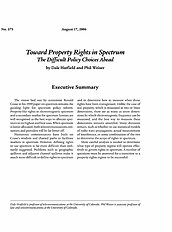The vision laid out by economist Ronald Coase in his 1959 paper on spectrum remains the guiding light for spectrum policy reform. Property-like rights in electromagnetic spectrum and a secondary market for spectrum licenses are well recognized as the best ways to allocate spectrum to its highest and best uses. When spectrum is better allocated, both telecommunications consumers and providers will be far better off.
Numerous commentators have built on Coase’s wisdom and charted paths to facilitate markets in spectrum. However, defining rights to use spectrum is far more difficult than ordinarily suggested. Problems such as geographic spillover and adjacent channel spillover make it much more difficult to define rights to spectrum and to determine how to measure when those rights have been transgressed. Unlike the case of real property, which is measured in two or three dimensions, there are as many as seven dimensions by which electromagnetic frequency can be measured, and the best way to measure these dimensions remains unsettled. Many decisions remain, such as whether to use statistical models of radio wave propagation, actual measurement of interference, or some combination of the two to determine the scope of rights in spectrum.
More careful analysis is needed to determine what type of property regime will operate effectively to govern rights in spectrum. A number of questions must be answered for a transition to a property rights regime to be successful.
About the Authors

This work is licensed under a Creative Commons Attribution-NonCommercial-ShareAlike 4.0 International License.
